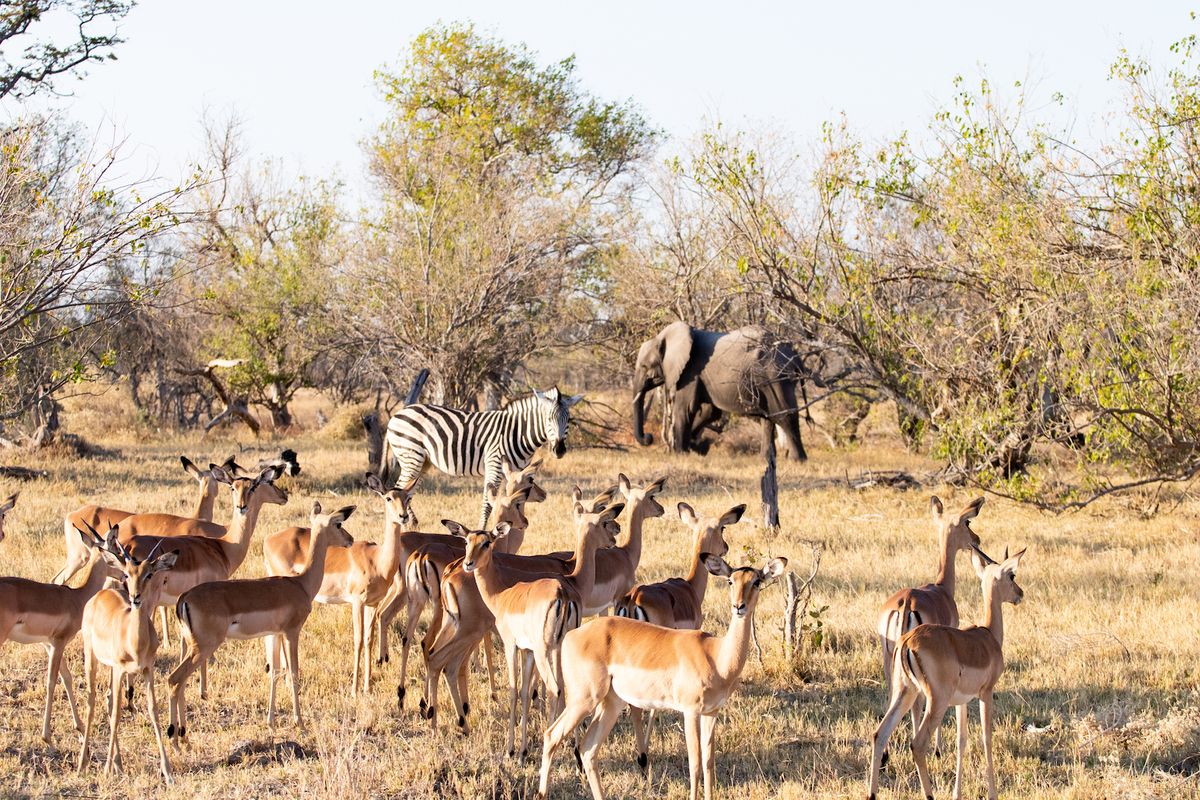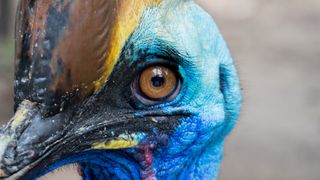What is taxonomy?
What should you call that bird? You couldn't go wrong with "dinosaur," taxonomists say.

If you saw a feathered, two-footed critter on the lawn, what would you tell people you saw? A robin? A blackbird? How about a dinosaur?
From a taxonomist's perspective, you couldn't go wrong with dinosaur. According to taxonomy, the discipline that assigns official scientific names to all known organisms, all birds are dinosaurs. "Robin" and "blackbird" are common names that may mean different things in different places, while the clade "Dinosauria" is a clear scientific designation — and it includes birds, which descended from the ancient giants.
Fundamentally, taxonomy is the science of naming, defining and classifying "biologically, evolutionarily distinct groups of organisms," said David Baum, a University of Wisconsin-Madison botanist who studies evolution and systematics. Stanford University biologist Paul Ehrlich puts it more simply in an essay on the Birds of Stanford website: "Taxonomy … is the science of classifying organisms."
The discipline of taxonomy analyzes how creatures should be grouped into different taxa (e.g., these particular birds make up a species distinct from that one); determines what to call those taxa (this bird species is Spinus tristis, the American goldfinch, and that one is Eudyptes robustus, a crested penguin); and lays out how smaller groups nest together into larger ones, such as how different species are grouped under one genus.
This nesting goes from species to genus, then on up through family, order, class, phylum, kingdom and domain. Hence, house cats, the species Felis catus, reside in the genus Felis, nesting within the family Felidae (along with other cats, such as tigers and bobcats), which in turn sits in the order Carnivora (with other carnivores, such as bears and walruses). This order nests inside the class Mammalia, which also includes zebras, whales and humans. Mammals are part of the phylum Chordata, which encompasses all vertebrates and more exotic creatures such as the sea squirt. This phylum lives in the kingdom Animalia, which is part of the domain Eukaryota, which encompasses everything with a nucleus in its cells.
Related: Prokaryotic vs. eukaryotic cells: What's the difference?
Taxonomy also decides on that two-part, binomial name of genus-plus-species that scientists use to formally designate a specific organism (Homo sapiens for us, Clostridium difficile for one of our unwelcome bacterial guests).
Those definitive names make taxonomy crucial to scientists, Baum told Live Science. "We need to have clear communication. So if I'm talking about a particular evolutionary group and someone else is [too], we know we're talking about the same thing," he said. "That's the fundamental reason we absolutely need taxonomy."
Taxonomy echoes evolution
Inherent in that usefulness is the way taxonomy groups organisms according to their relationships. In modern taxonomy, that means describing evolutionary links. A taxonomic group must always refer to a set of organisms that descended from the same ancestor, at some point in evolutionary history. Species within the same genus all share a common ancestor. The same goes for each genus within one family and so on.
Taxonomy is so intertwined with evolutionary theory, in fact, that it can be difficult to delineate when a researcher's "doing taxonomy" and when they're "doing evolutionary biology," Baum said.
Related: What is convergent evolution?
Classically, a taxonomist engages in taxonomy by examining the various features of an organism or group of organisms, comparing them against known examples, and then, if warranted, reassigning names or assigning new ones. A taxonomist might take a set of specimens and separate potentially different species, as the UN Environment Programme's Secretariat of the Convention on Biological Diversity describes.
The investigator would then check whether these groups already had names, sometimes by reading centuries-old specimen descriptions, or comparing against samples from museums and herbaria. They'd look at external and internal traits and maybe even analyze DNA. Should those comparisons show no matches, the taxonomist would write up a description and assign a new species name in accordance with the complicated rules of taxonomic nomenclature. Then, the finding would be published.
That work can involve a bit of evolutionary discovery, beyond just naming. In practice, taxonomists are doing evolutionary biology, Baum said. "They're reconstructing evolutionary history. And so all the time they're discovering new evolutionary relationships among organisms."
The field's interdependence with evolutionary theory also means that taxonomy in turn must respond to evolutionary discoveries. So, groupings and names can change, sometimes dramatically.
Reptiles, for example, originally encompassed lizards, snakes, turtles and crocodiles. Birds were considered distinct. Over time, however, scientists found that crocodiles were more closely related to birds than either of them were to other reptiles. (This was found first via morphological studies but later well-confirmed via molecular analysis, Baum said.) This left taxonomists in a quandary about what the grouping "reptile" should refer to, as one of its core members was now seen to be more closely related to an outsider, Baum said.
"If the taxonomy doesn't reflect evolutionary history properly, and people assume that it does, then they tend to make mistakes ..."
- botanist David Baum
Related: Are birds dinosaurs?
Taxonomists could have reserved the term "reptile" for referring to the noncrocodile members (snakes, lizards and turtles), as crocodiles were more closely related to birds. Instead, scientists expanded reptiles to now include birds.
Expanding even further, scientists eventually accepted that one group of dinosaurs, the theropods, are more closely related to birds than to any other reptiles. (Evidence for this built over the years, beginning with the bird-like Archaeopteryx in the 1860s and continuing through the discovery of many feathered dinosaurs in the 1990s.)
Again, taxonomists could have restricted the term "dinosaurs" to those dinos from which birds didn't descend. But researchers instead opted to maintain the grouping of all previously recognized dinosaurs, as Dinosauria, while acknowledging birds as the descendants of one dino branch.
Related: What's the difference between alligators and crocodiles?
By responding to evolutionary findings like this, taxonomy does more than change nomenclature: It helps scientists avoid errors, Baum said. "If birds had been kept taxonomically separate from crocodiles, biologists would tend to make assumptions that crocodilian anatomy and physiology would resemble that of lizards, instead of looking to the birds," he said. "If the taxonomy doesn't reflect evolutionary history properly, and people assume that it does, then they tend to make mistakes in inference. They tend to jump to false conclusions."

Who invented taxonomy?
Evolution hasn't always played this role in taxonomy, however. Today's hierarchical, ranked system originated with Charles Linnaeus, an 18th-century Swedish botanist. Linnaeus didn't subscribe to Darwin's theory — partly for the forgivable reason that it hadn't been invented yet. So the first huge milestone in modern taxonomy's own evolution, Baum said, came with the incorporation of evolutionary theory. "Since Darwin, there was an intention to reflect evolutionary history in the taxonomic system."
Exactly how to do that, however, remained unclear until the mid-1900s. Then, German scientists like Willi Hennig showed that "if you want to reflect evolutionary history, then you should only give names to … these groups that all come from a common ancestor," Baum said.
Today, these "monophyletic groups," or groups that descend from a common ancestor, govern how taxonomists delineate taxa, with groups branching off the tree of life from their common ancestors. That's why every genus in a family must share a common ancestor and so on. "Just like on a regular tree, imagine grabbing a branch and saying, 'Well, everything that is down on this branch, we're going to give it a name," Baum said. That's a monophyletic group.
Other major events in taxonomy's own evolution served to reinforce the insights of Darwin and Hennig. The advent of DNA analysis has helped scientists more accurately measure how related organisms are, and leaps in computational power have since accelerated those genetic discoveries, Baum said.
The problem with classic taxonomy
But in the midst of this gleaming, modern computational era, taxonomy retains traces of its centuries-old roots — which some scientists, including Baum, refer to as baggage.
The binomial names, for starters, grew from Linnaeus' pre-Darwinian mindset. For Linnaeus, Baum said, "The genera were what God created, and after the creation, there were some rearrangements that happened to generate different species of the genus. So genus was the kind — 'genus' means 'kind' in Latin — [and] species were the variety, the modification of that."
Thus, the very naming system that gives us Homo sapiens and Tyrannosaurus rex reflects a Creationist view, Baum said.
Related: Why creationists are more likely to buy into conspiracy theories
"A class of snails cannot be meaningfully compared with a class of fish."
- phylogeneticist Ronald Jenner
For Baum and others, taxonomy's "baggage" weighs down the whole classification system, particularly because of the ranks. The important information in taxonomy, these scientists argue, is that delineated groups share a common ancestor, not whether they count as genus, phylum, family or order. Such rankings suggest an equivalency across taxa that doesn't correspond to reality, Baum said.
One phylum, for example, could have a far different range of diversity and timeline of evolutionary divergence than another, despite both being phyla, Christie Wilcox wrote in Quanta. "The ranks don't mean anything specific or uniform across all groups of life," she wrote.
"A class of snails cannot be meaningfully compared with a class of fish," London Natural History Museum phylogeneticist Ronald Jenner told Quanta.
An alternative system might just classify organisms by their monophyletic groups — the nested taxa that share common ancestors — without assigning rank names. "You would still have the Mammalia. It just wouldn't be a question, is the Mammalia an order, is it a phylum, is it something else?" Baum said. "You could still teach a student these are the big groups you need to understand without implying that they have some comparability — you know, this family and that family bear something in common as families. Because they don't."
Related: Astronauts spent 6 nights in a pitch-black cave, and emerged with a brand new species of crustacean
One big step toward such taxonomic reform arrived recently, with the latest version of PhyloCode publishing in 2019. This project aims to "redesign the nomenclatural system so that you could decide the correct name of a taxon [group of related organisms] independent of rank," Baum said. Under this system, "Mammalia" might be defined not as a class, but as all those organisms sharing a most recent common ancestor with humans and platypuses, Baum said. The name Mammalia would still refer to a group with a common ancestor, but there would be no rank like "class" incorrectly suggesting that the group was similar in size or diversity to other classes.
Building this alternative system, however, will require an enormous database of phylogenetic definitions — definitions of groups that are closely related. That's a massive, ongoing project, Baum said. PhyloCode remains controversial among biologists and taxonomists, and the effort will continue alongside the traditional classifications, definitions and nomenclatural battles that have occupied taxonomists for centuries. So for now at least, scientists still turn to the traditional form of taxonomy to assign newfound species their names and their spots on the tree of life.
Additional resources:
- Find taxonomic information about North American organisms from the U.S. government's Integrated Taxonomic Information System.
- Read about taxonomic "vandals" at Smithsonian Magazine.
- Learn more about the PhyloCode project from the International Society for Phylogenetic Nomenclature.
Sign up for the Live Science daily newsletter now
Get the world’s most fascinating discoveries delivered straight to your inbox.

Michael Dhar is a science editor and writer based in Chicago. He has an MS in bioinformatics from NYU Tandon School of Engineering, an MA in English literature from Columbia University and a BA in English from the University of Iowa. He has written about health and science for Live Science, Scientific American, Space.com, The Fix, Earth.com and others and has edited for the American Medical Association and other organizations.












